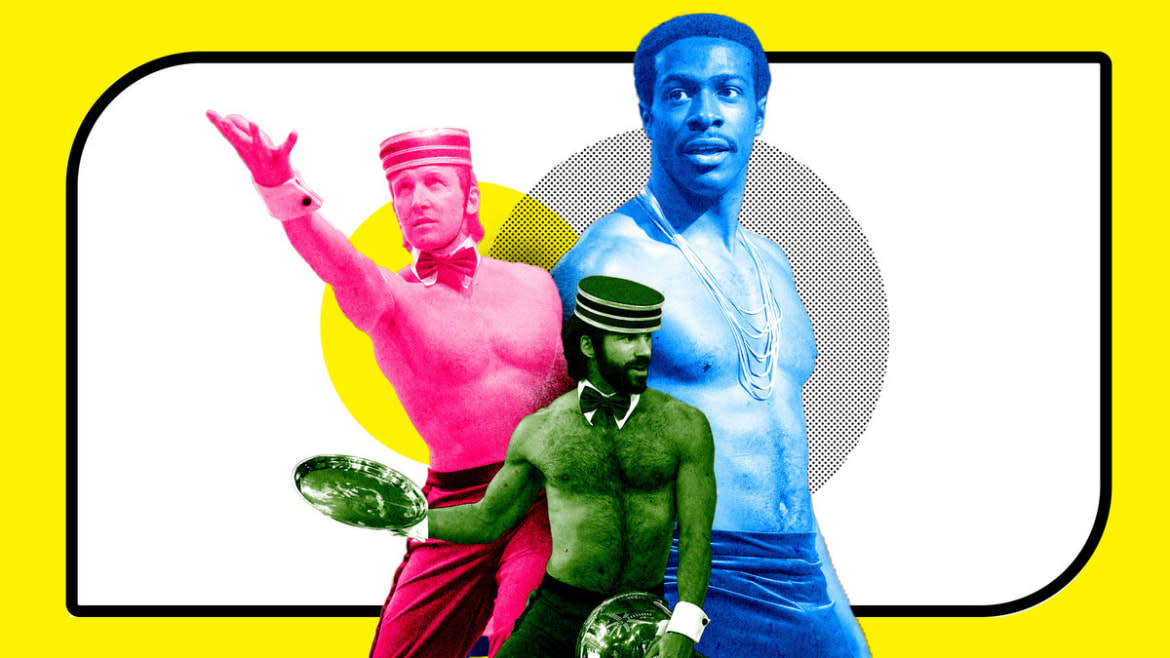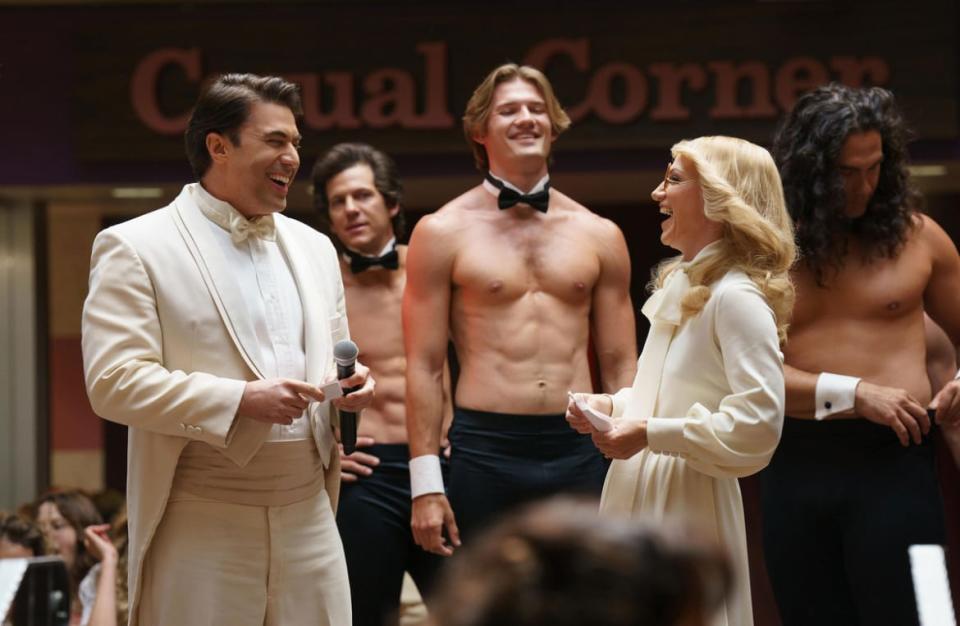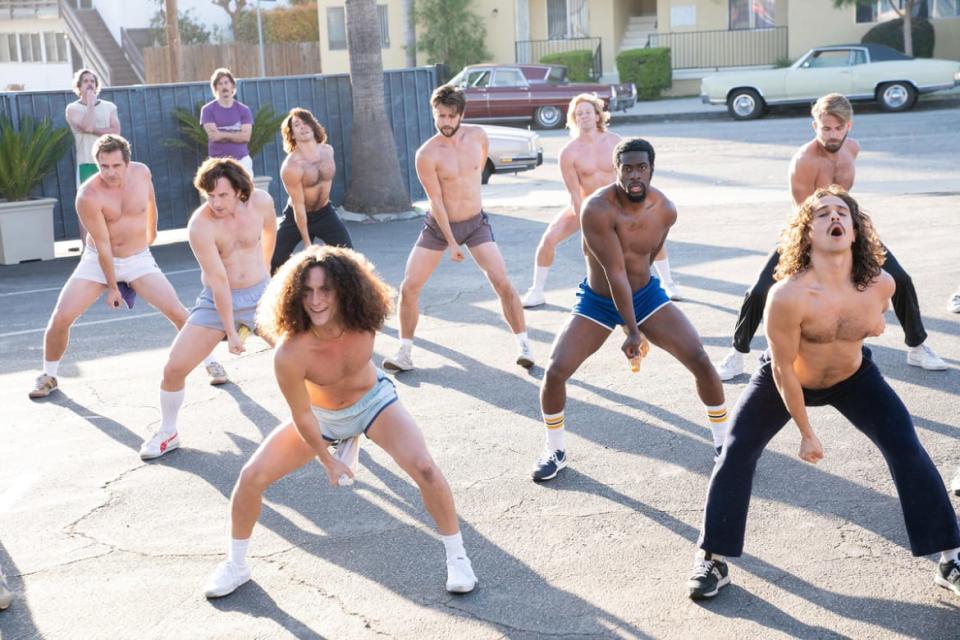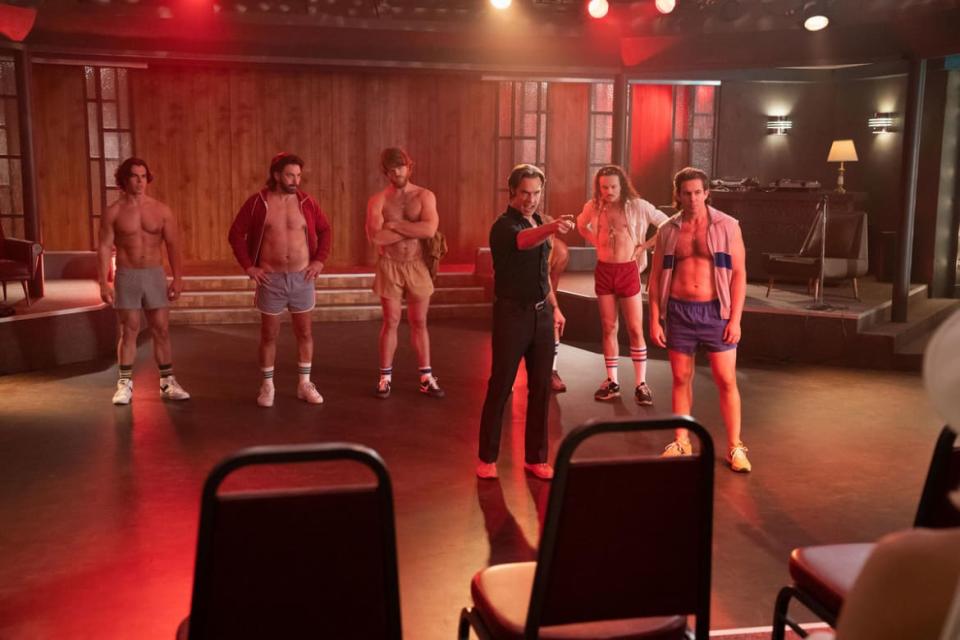The ‘Welcome to Chippendales’ Secret to Making Pants for Male Strippers to Take Off

- Oops!Something went wrong.Please try again later.
No one wants to watch a stripper who can’t get his pants off.
Early scenes in Welcome to Chippendales depict inexperienced male dancers struggling to remove their pants during performances. Thankfully, by the time the strippers and their signature collars and cuffs make their New York City debut in the fifth episode, it is a polished showcase ready to take the world by storm, one metallic G-string at a time.
The Hulu limited series chronicles the unexpected rise of the Chippendales troupe of exotic dancers in the late ’70s and early ’80s through the people behind the scenes who helped create an empire. Key to that was innovative costume designer Denise (Juliette Lewis), who comes up with a failsafe breakaway technique that turns awkward undressing into lightning-quick disrobing.
It became Welcome to Chippendale’s real-life costume designer Peggy A. Schnitzer’s challenge to bring that era’s fashion—not just sexy dancers’ outfits—to life, providing the heart of this twisted story about an American Dream that slowly transforms into a true-crime saga.

Schnitzer spoke with The Daily Beast’s Obsessed about capturing this period of excess, how New York style contrasts with the L.A. look and the challenges of constructing the Chippendales' easy-to-remove attire.
“[When we began,] we used regular clothes, and they took their pants off, but once we started doing the breakaway pants, every pair of pants was made specifically for each dancer,” Schnitzer says, talking about the pivotal custom-made garment. Ditto for every performance G-string.
Creating the tearaway clothes was Schnitzer’s most significant challenge, as she doesn’t have a background in musical theater or dance and these pants needed to “work functionally and still look good.” The solution? Schnitzer sought advice from a colleague with experience in this field: none other than the costume designer for Magic Mike and its sequel, Magic Mike XXL, Chris Peterson. (Talk about going to the expert…) “I'm gonna save you hours of tears and frustration,” Schnitzer recalls Peterson telling her.
‘Welcome to Chippendales’ Star Murray Bartlett Is Too Embarrassed to Strip for You
While it was still a process of trial and error to design efficient rip-away pants—while still looking good—Peterson advised her about “the types of fabrics that would work better.” Two types of performance pants are required for different purposes. Stretch is needed to accommodate the vigorous dancing and thrusting moves, while rigidity is necessary to pull off the big G-string reveal. Structured material combined with snap tape maintains the tension for the breakaway portion, which needs to hold together to avoid popping open too early. “Then we had to figure out how much [snap tape] you’re going to use, because there are stress points on the body—around someone’s butt, on their hips—and they have to work it,” Schnitzer says. “They put their thumb in and pull forward; they don’t just come off.”
Not all of the show’s dances and performance themes are exact recreations of what the original Chippendales did, but they were all inspired by the classic routines. The brilliant and ambitious “Hunkenstein” rock opera, which is immediately vetoed by Chippendales owner Steve Banerjee (Kumail Nanjiani), is seemingly based on a Chippendales crowd-pleasing routine called “The Perfect Man.” In this week’s new episode, the Chippendales’ New York opening features a centerpiece performance in which breakaway pants become breakaway shorts that are enthusiastically thrown into the audience.

Short shorts are not only a Colin Farrell favorite, but a staple of the series, worn by the dancers during rehearsals and downtime. The performers’ dolphin shorts, striped socks, and tanks are some of the many vintage pieces Schnitzer sourced for the series. She and her team scoured every costume shop in L.A. “We were fitting 80 people a day for those club scenes,” Schnitzer says. “There's also the warehouses that eventually put their clothes in different vintage stores that you can go through, and we had people doing that as well.” They would spend up to 10 hours a day pulling stock that needed washing before it could get added to the vast collection.
“It was a massive job to cover and make sure everything not only looks good on its own, but also worked with the production design, within the room, and with the other colors everyone was wearing,” Schnitzer says. “It was worth it. Every day was like a dream.”
At the midway point of Welcome to Chippendales, the series becomes a bicoastal story, as Nick (the choreographer played by Murray Bartlett) and Denise move to New York to get away from Steve’s suffocating style. “I grew up in Los Angeles, but then moved to New York in the late ’70s. So I’m very aware of stuff that happened at that time,” Schnitzer says

She moved back to L.A. in the early ’90s, so she understands the “definite difference aesthetically” between the East and West Coasts. “I remember going to clubs in New York, and there was a lot less color than in Los Angeles. It was much more blacks and golds,” she says. When Nick and Denise strut through Manhattan, there is a noticeable but organic shift toward monochromatic styling. “That, to me, was what it looked like when I lived there. Primarily, there wasn’t a bunch of color on the street. There might be a hit of color here and there.”
In Los Angeles, Nick is “almost borderline cheesy,” wearing printed shirts unbuttoned that reveal Bartlett’s chest hair. Nick’s showy closet is toned down in the New York episodes, and denim replaces patterns, reflecting Calvin Klein’s influence—keep your eyes peeled for a fun reference in a later episode.
How Chippendales’ Male-Stripping Empire Ended in Bloody Murder
In contrast, other than adding more leather, Denise doesn’t change much from when she first tells Nick that she is “a vision facilitator” and “a fucking magician with a sewing machine.” Because work is also the club, Denise is “always dressed” for nightlife. “I found these jumpsuits because I thought that would be a perfect functional thing that she could look incredible and work in. She could move around and have this freedom and liberation of being able to move in her clothes but still look super clubby, super sexy, and super hot,” adds the designer.
Denise moves through the world so effortlessly, which is how she approaches her design work on the Chippendales. Efficiency doesn’t sound particularly alluring, but clothing removal needs to be seamless in a world in which fantasy is the experience. Similarly, Schnitzer has tapped into the essence of the dancers beyond the signature bowtie, cuffs, and tight black breakaway pants. It almost feels like you can smell the sweat through the screen. “Functionally, visually, and aesthetically, I felt creatively satisfied,” she says.
In Welcome to the Chippendales, it doesn’t matter if you’re seeing the dancers in Los Angeles or New York, snap tape is king.
Get the Daily Beast's biggest scoops and scandals delivered right to your inbox. Sign up now.
Stay informed and gain unlimited access to the Daily Beast's unmatched reporting. Subscribe now.

